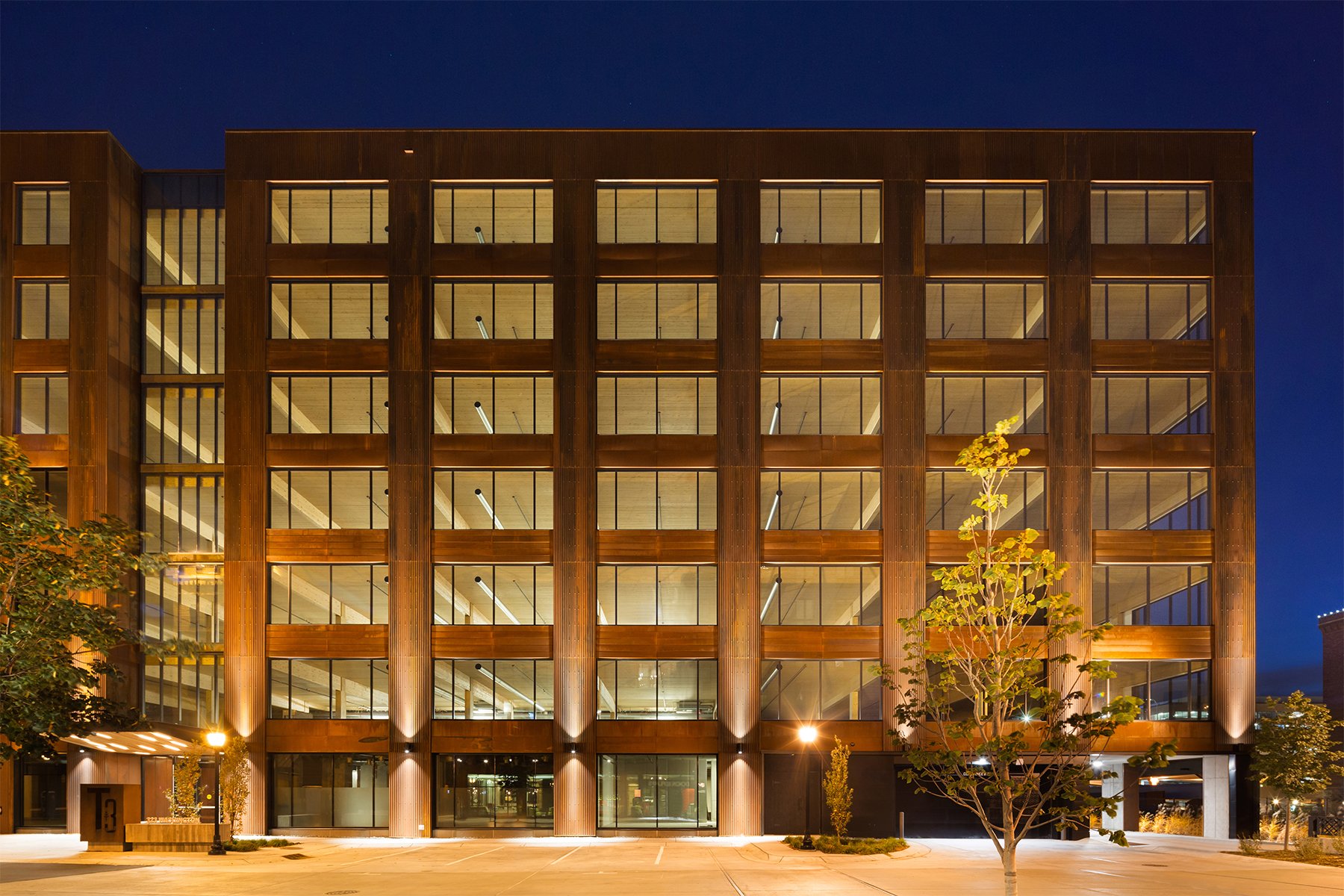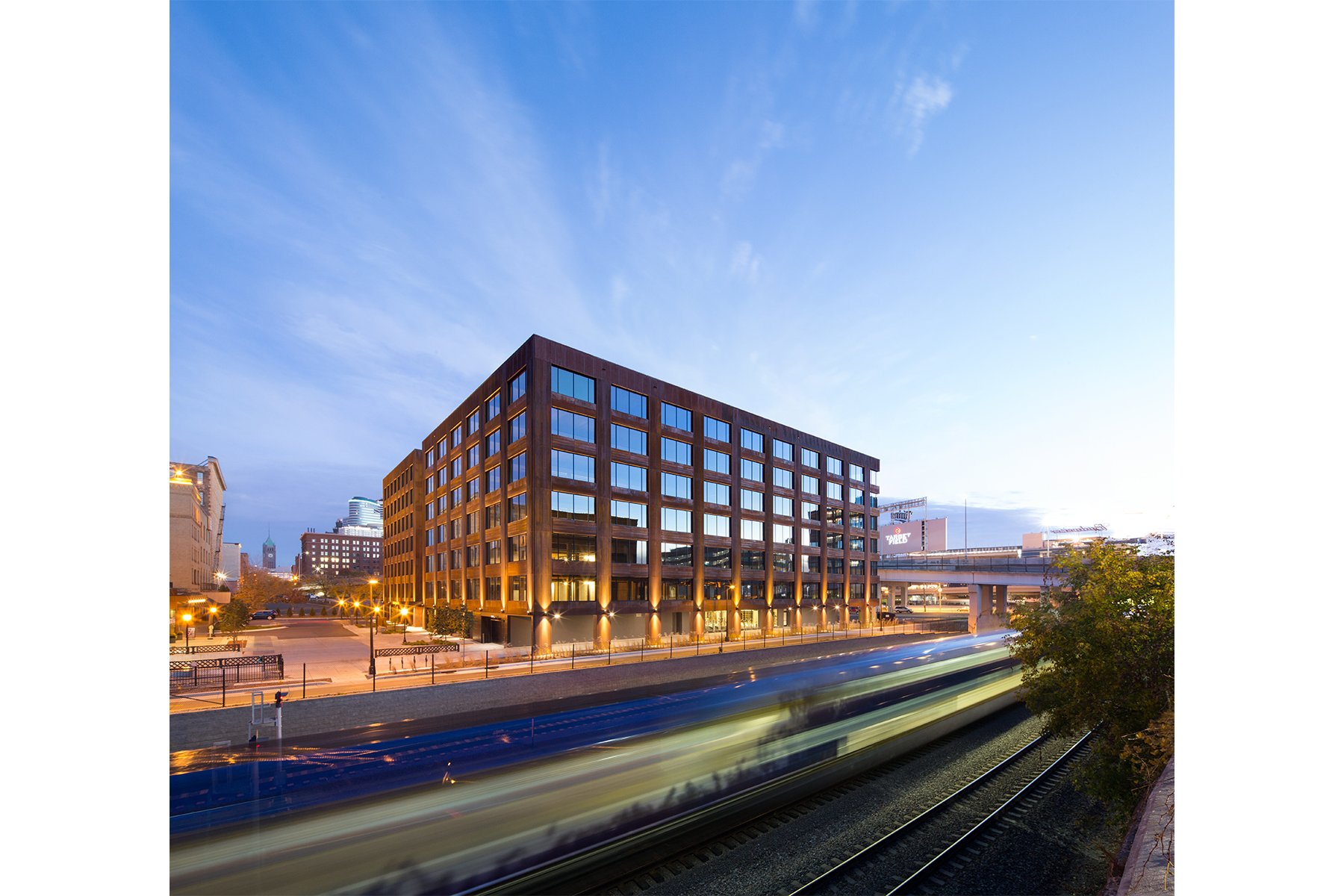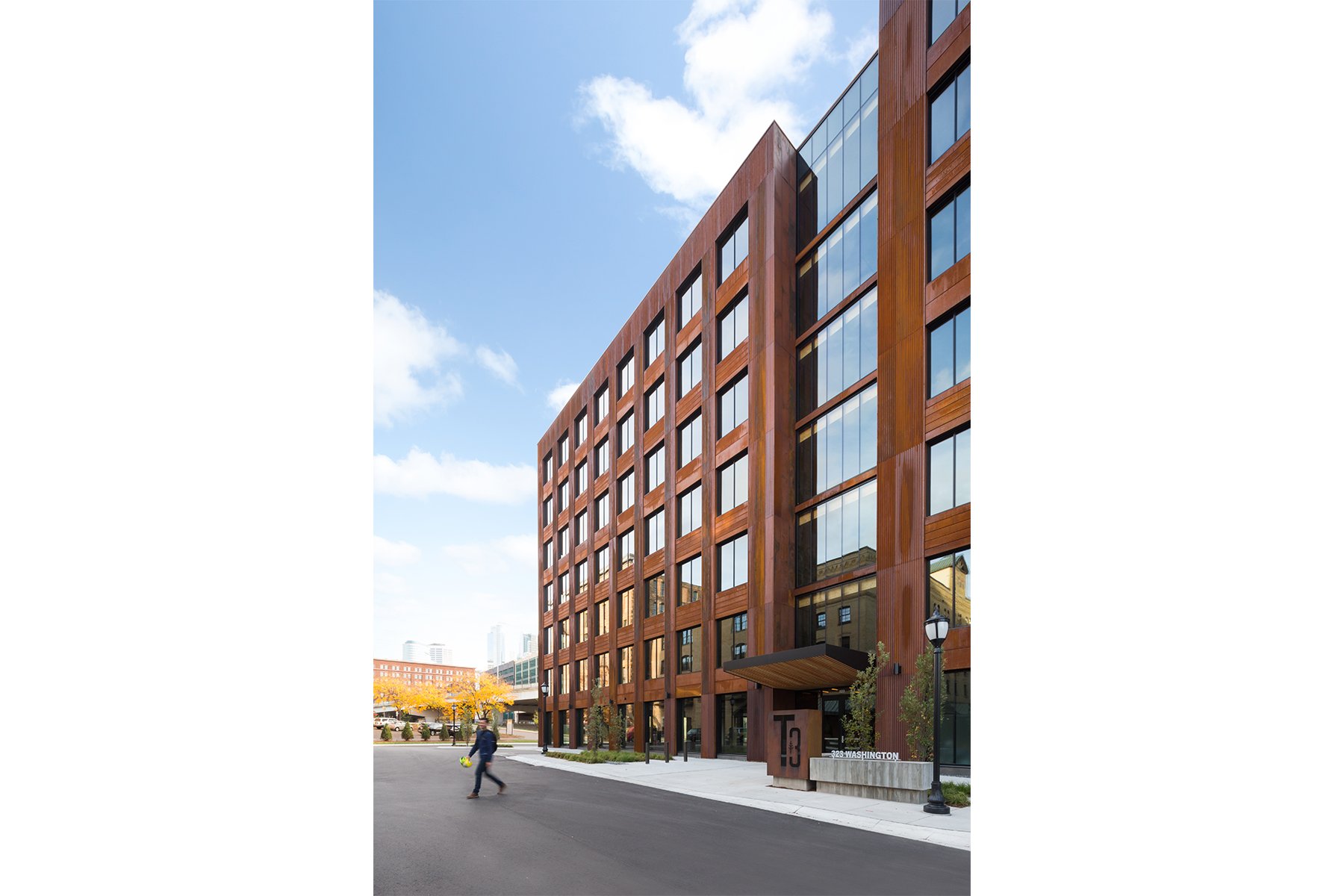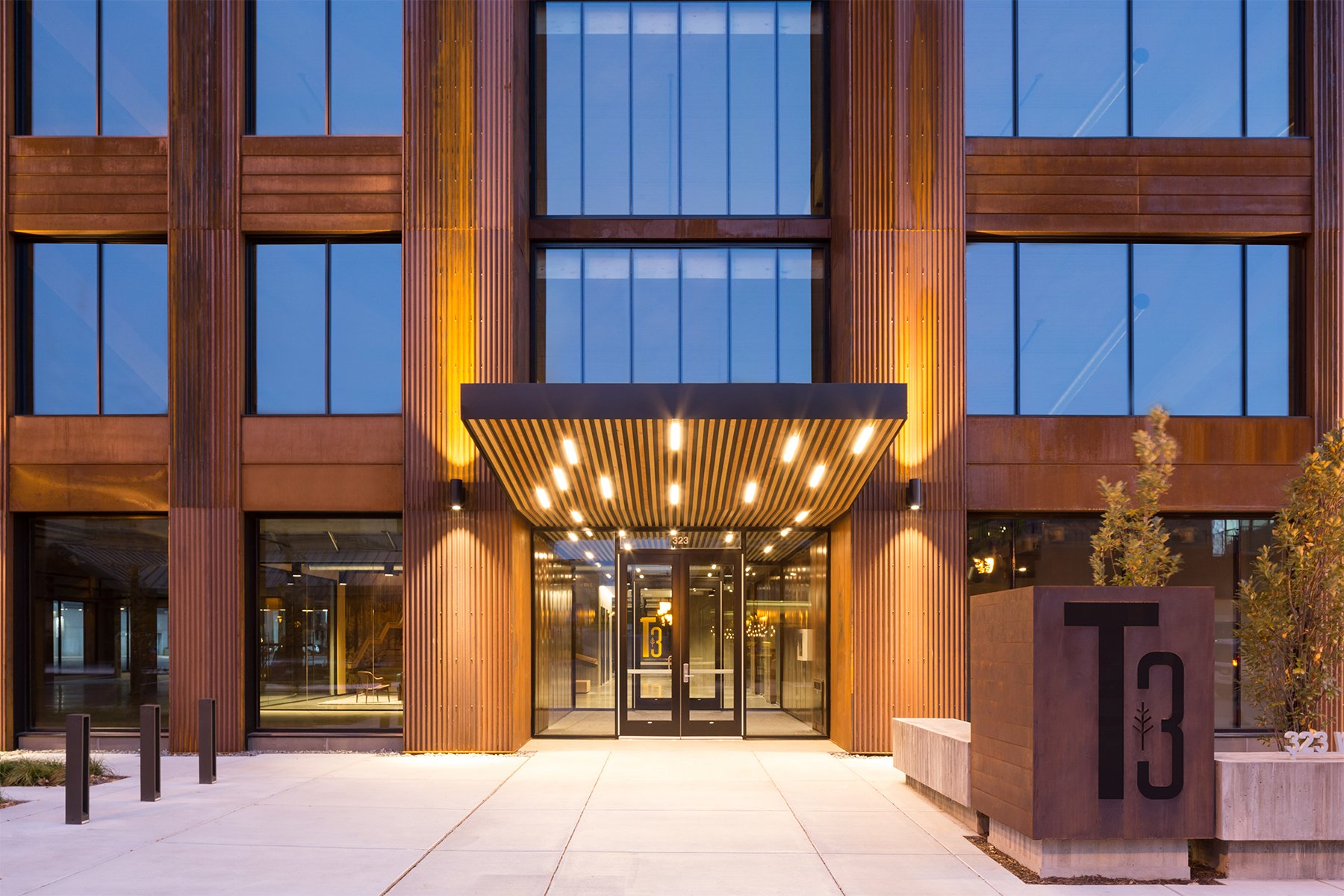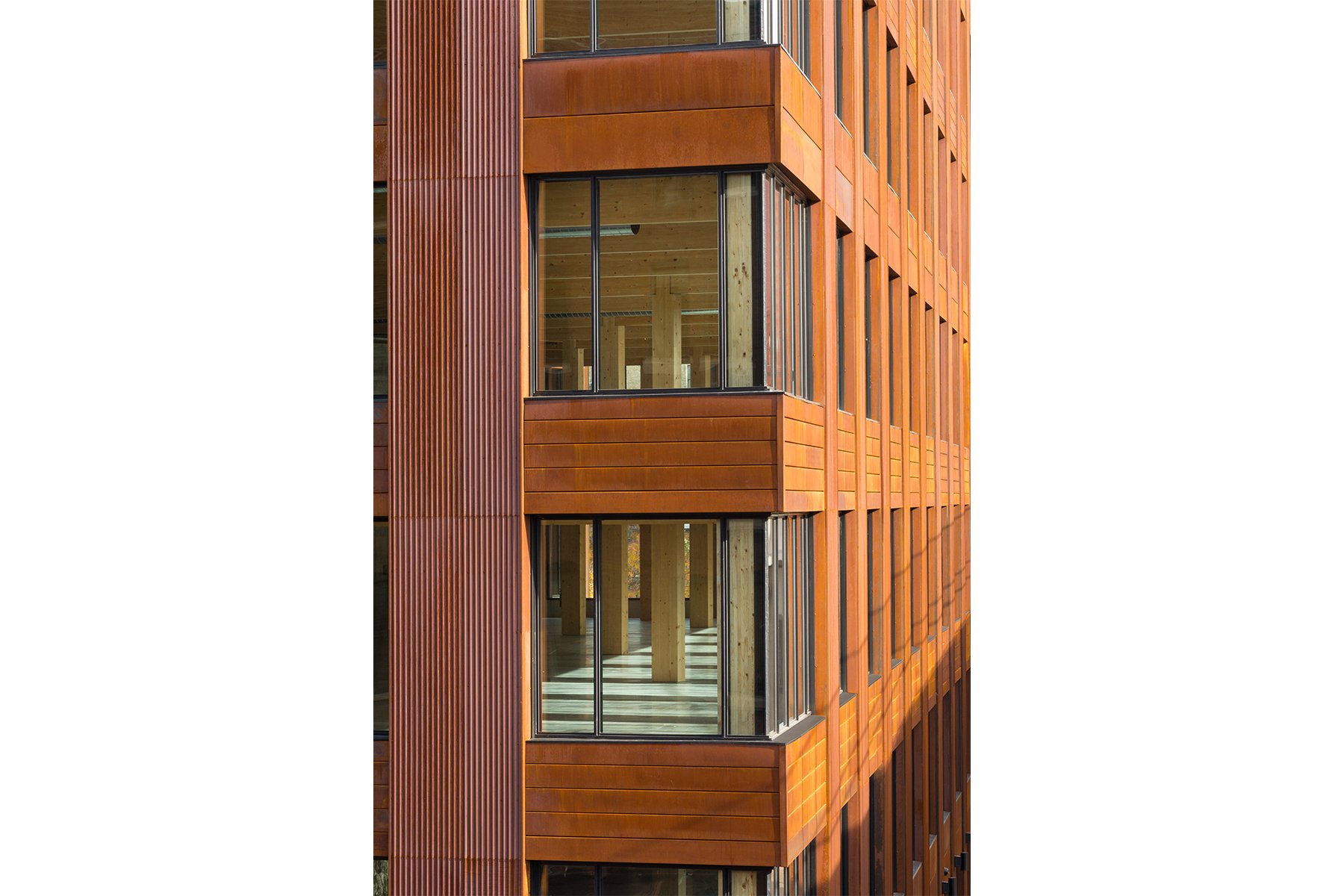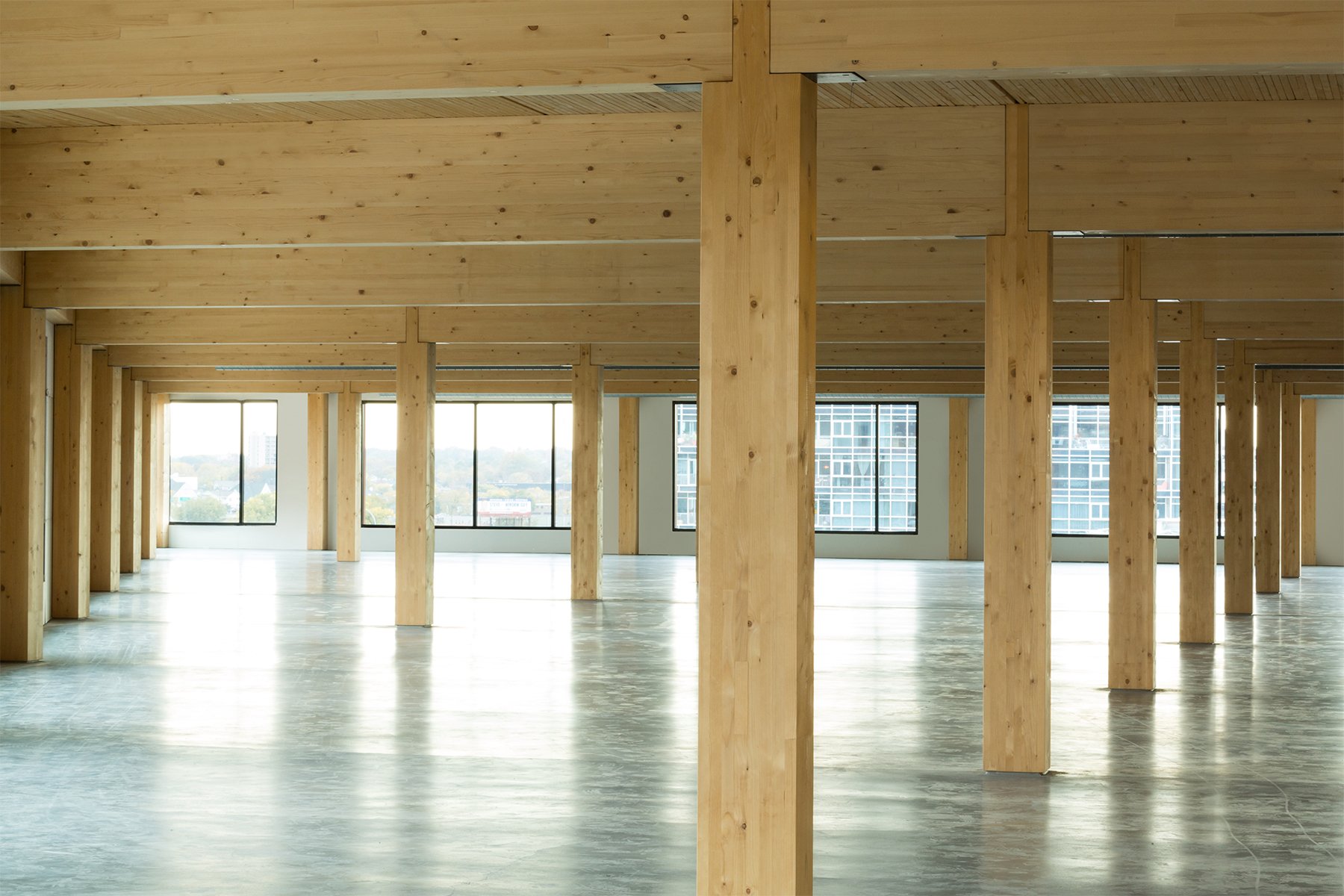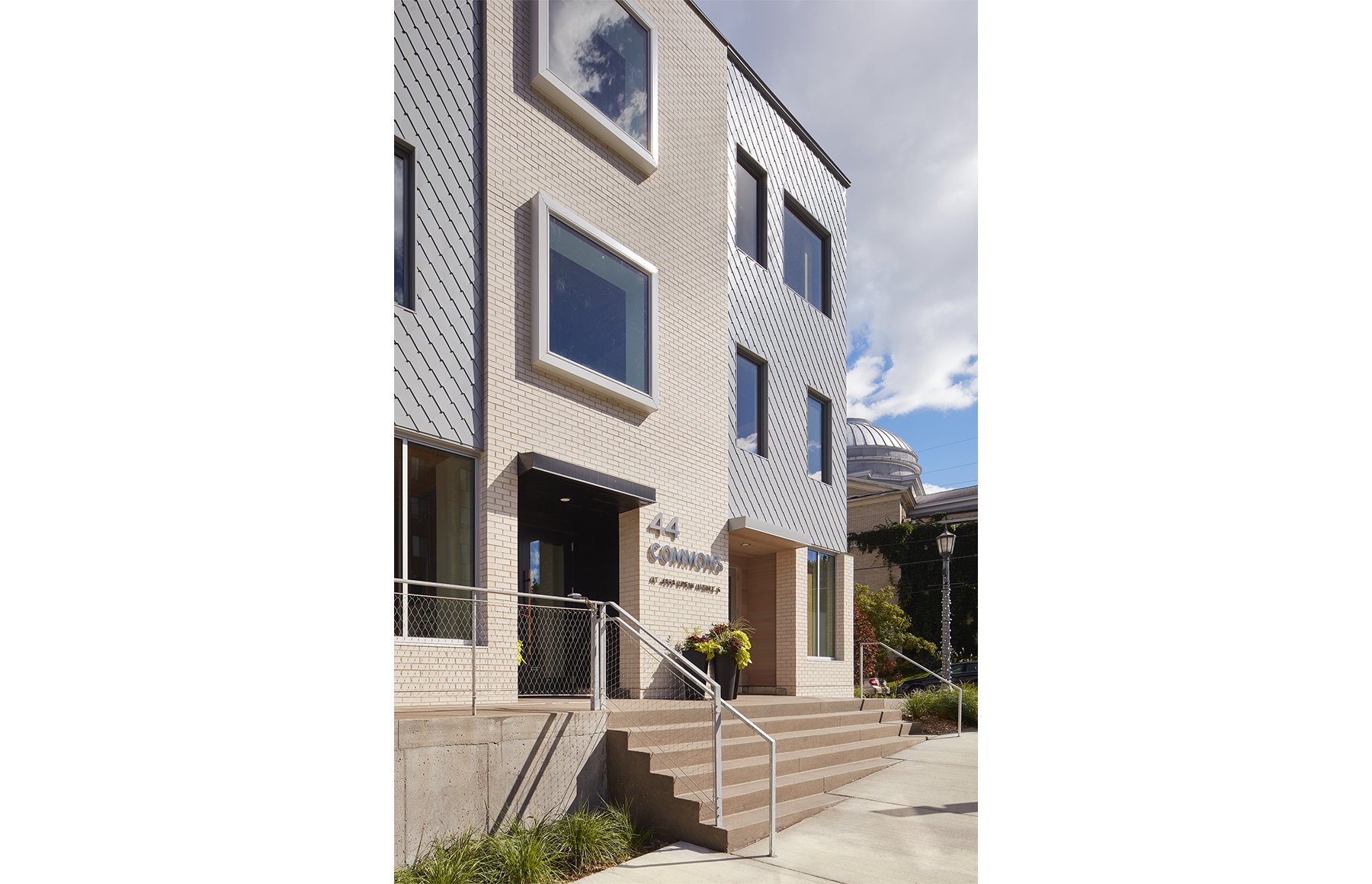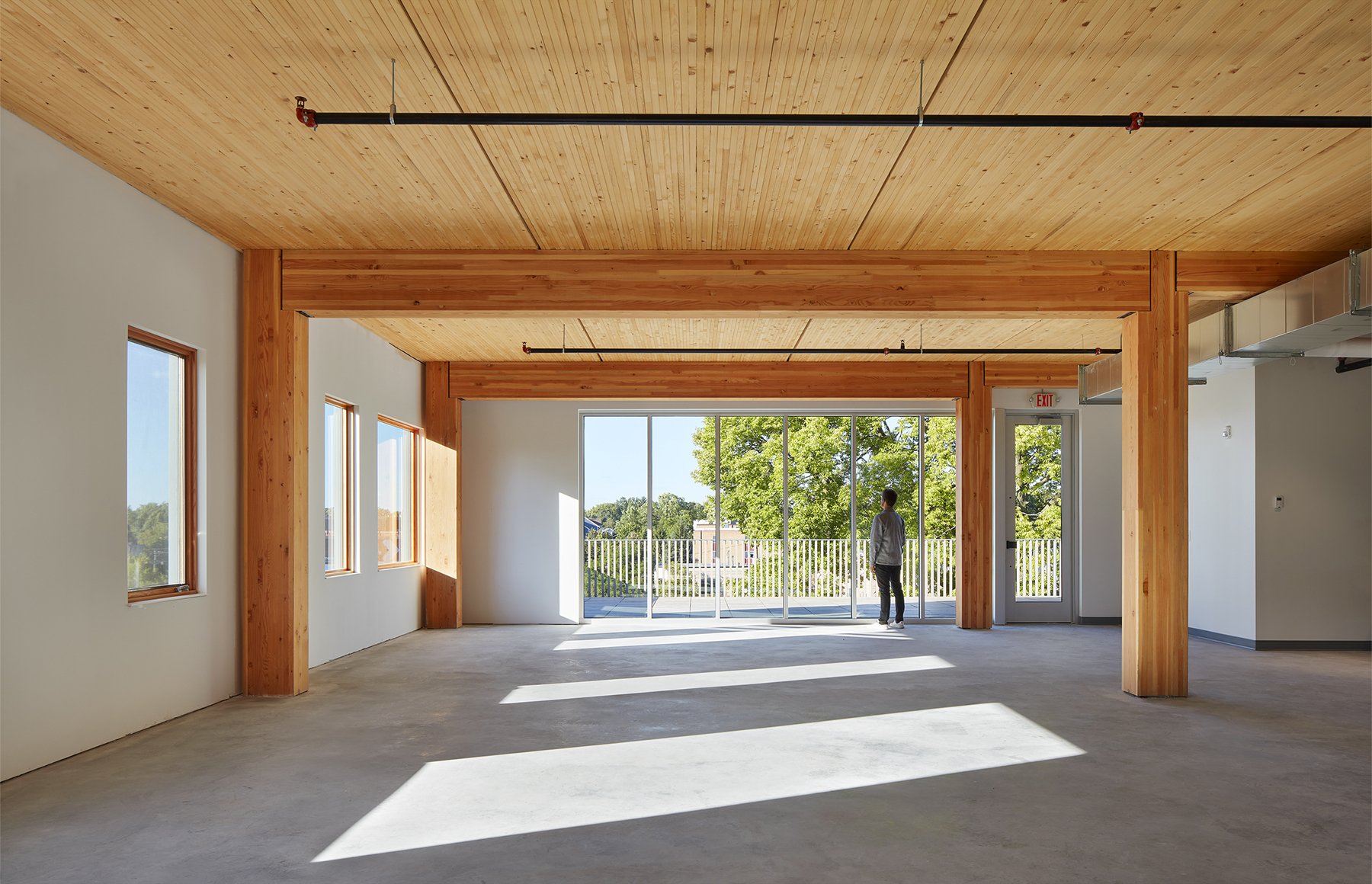The State of Mass Timber in Minnesota
Industry observers, forestry experts, and architects speak with ENTER about the challenges and opportunities in growing market demand for an environmentally friendly construction method
By Justin R. Wolf | May 2, 2022
Clad in weathering steel, T3 in Minneapolis reveals its mass-timber superstructure inside and out, especially when illuminated from within at night. Photo by Ema Peter Photography.
2022 PRINT ANNUAL
This feature appears in the 192-page, 2022 ENTER print annual, available for purchase here.
What’s old is new again: Mass-timber construction is having a moment. Since 2013, more than 1,300 mass-timber projects across all 50 states have been constructed or are now in design, according to the nonprofit WoodWorks. In the last few years, across select regions of the country, architects and developers of large-scale mass-timber buildings have engaged in their own “race into the sky,” with new world records for height being set every couple of years, on average. But there are caveats to these advances, and this sustainable building method isn’t poised to supplant concrete or steel anytime soon.
The obstacles to making mass timber more commonplace in Minnesota don’t fall into one category, but they are very much interconnected. Despite being home to the country’s first modern, tall wood building—the seven-story, 220,000-square-foot T3 in Minneapolis’s North Loop, which opened in 2016—as well as some 17.6 million acres of forestland and an abundance of sawmills, Minnesota remains well behind the curve, ranking behind 21 other states in terms of projects built and in design. So, what’s holding Minnesota back?
“The main reason is probably fiscal conservatism,” says Steve Cavanaugh, AIA, a principal with DLR Group, the architect of record for T3. “Making buildings out of wood is a centuries-old practice. But the idea of mass timber as a superstructure for large commercial buildings . . . that’s a new thing, and there isn’t a lot of data available.
Images 1–6: T3 stands for timber, transit, and technology. It sits at a focal point of the transportation network of the Twin Cities. The open plan for each floor features and 11-foot-high ceiling with windows running nearly floor to ceiling. All photos by Ema Peter Photography.
“Development companies are classically averse to risk,” he continues, “so when you don’t have a deep catalog of cost modeling for mass timber, it’s going to give them trepidation. You can jump up and down until you’re blue in the face telling everybody how sustainable it is—the biophilic benefits and so on—but in the end, it comes down to getting the project financed.”
The pandemic hasn’t helped matters. In May 2020, the D/O Architects–designed TMBR project, once slated to become the tallest all-wood building in the Midwest, was shelved by its developer and replaced with plans for a traditional stick-built apartment building.
“The sales tool for these projects is speed, because the material costs are higher,” says Colin Oglesbay, Assoc. AIA, founder and managing principal of D/O Architects. “Just from a structural systems perspective, mass timber is about five dollars more per square foot than traditional concrete construction, which is not inconsequential when you’re doing a 200,000-square-foot building. But as more people realize the speed element, mass timber will get more competitive.”
Another challenge, says Oglesbay, is that few contractors are proficient in the different forms of mass-timber construction, including cross-laminated timber (CLT), dowel-laminated timber (DLT), and glue-laminated timber (glulam). “Any contractor coming in sees it as a risk because they don’t 100-percent know what they’re doing,” he says. “But a timber crew is six people. You can put up pretty big buildings without a lot of people.”
While the dual incentive of construction speed and staffing efficiency may not offset concerns about material costs and know-how for all owners and developers, the outlook for mass timber seems bright, especially in the Midwest. But that outlook is tempered by the fact that the region isn’t as rich in resources as most people might think.
“Here in the Midwest, we are not a large softwood-lumber-producing region compared to the South and Pacific Northwest,” says Kristen Bergstrand, a timber utilization and marketing consultant with the Minnesota Department of Natural Resources (DNR) Forestry Division. There are 10 major manufacturing centers in North America for mass-timber products, the bulk of which produce CLT, and seven of those are in either British Columbia or the northwestern U.S. Further, mass timber is made exclusively from softwood conifers like fir, pine, and spruce, and Minnesota’s most abundant tree species is aspen, a hardwood. “That’s not as favorable in terms of spurring new production development,” says Bergstrand. “But on the flip side, we have regional softwood production, robust secondary wood manufacturing infrastructure, and proximity to Canadian softwood imports.”
Things like raw material costs, labor shortages, and a general lack of familiarity with the practice all make Bergstrand’s list of reasons why mass timber hasn’t boomed in her home state. But she stops short of characterizing Minnesota’s low numbers as a missed opportunity. “Wood has been out of favor for a long time,” she explains, “and it’s taking a while to bring it back, even though there are documented environmental benefits in why you would want to use wood as a raw material versus concrete or steel.”
These benefits include carbon sequestration and storage, as well as favorable impacts on forest management and the use of carbon credit programs.
“What is solar energy, really?” asks Kyle Gill, a forest manager with the University of Minnesota Cloquet Forestry Center. “Trees are the original solar panels. They take the waves of the sun and turn them into something usable, and we as foresters have pretty good knowledge on how to make the forest grow again.”
“Where there’s a will, there’s a way,” goes the old saying; throughout most of the U.S., the will simply hasn’t yet taken hold. Bergstrand notes that, up until quite recently, tall mass-timber buildings could only happen on a project-by-project basis. This was largely because most states were slow to adopt the International Code Council’s (ICC) new building codes, which went into effect in 2021 and permit the use of mass timber in construction types up to 18 stories or 270 feet tall.
Prior to 2021, most state building-code councils were content with smaller-scale wood construction, if any at all. Among a handful of notable exceptions is Washington, which in December 2018 revised its own building code to allow for the very changes the ICC had just voted on. (Today, Washington has more than 120 mass-timber buildings built or in design, placing the state behind only California nationwide.) In other instances, cities including Denver and Milwaukee endeavored to obtain code variances for individual buildings at the municipal level. But, to date, these exceptions have only proven the rule.
A growing cast of architecture and engineering firms are champing at the bit to position themselves as leaders in mass timber, even in the context of currently limited opportunities.
Other concerns that have been raised about mass timber relate to fire mitigation, moisture control, and structural soundness—despite a multitude of tests that have proven mass timber’s high strength, dimensional stability, rigidity, and favorable fire and seismic performance. “There’s some older thinking out there,” says Bergstrand. “We really need developers and architects to be speccing these buildings and driving the market demand.”
While Minnesota is behind the coasts in manufacturing and construction, the U.S. is likewise behind both Europe, where well-managed alpine forests concentrated in Austria and Germany provide an abundance of softwood lumber for CLT production, and Canada, which launched its Wood First Program in British Columbia over a decade ago. Canada also encourages its forest industry and design professionals to continually innovate the built environment through the use of wood and climate-friendly construction practices.
“Policies that influence design and construction enable mass timber,” says Kathryn Fernholz, president and CEO of Dovetail Partners, a Minneapolis-based environmental nonprofit. “I’m not aware of any efforts in Minnesota to ease that on-ramp for mass timber, and those efforts have helped in other regions. Any time an industry expands, there are usually different incentives and policies that have supported the growth. That’s not happening here.”
In addition to a lack of policy efforts at the state level, Fernholz points out the lack of a clear “connection to the softwood industry and softwood lumber, which is the most straightforward raw material for making CLT and mass timber. We don’t have a manufacturing industry in that category that can naturally transition into making that product.
“What we do have,” she adds, “is a diversified forest and a strong forest products industry overall.”
With these two strengths as a jumping-off point, a Duluth-based consortium called Area Partnership for Economic Expansion (APEX) published a joint study with the University of Minnesota Duluth in 2019 that examined the economic feasibility of manufacturing CLT in the state. The study found that regional sawmills in the Great Lakes region reported producing 300 million board feet of lumber in species and grades that are suitable for CLT production. (Nearly three-quarters of that production was red pine, Minnesota’s state tree.) The study concluded, somewhat more modestly, that a large firm or cluster of CLT manufacturers operating in Minnesota would generate $12.4 million in new labor income, and that for every local CLT employee the state could see an additional 0.9 workers in supporting industries.
“We had to spend some time proving that we had access to the lumber, and we proved that. We certainly have the infrastructure that’s needed for mass-timber manufacturing,” says APEX president and CEO Brian Hanson. “So, when panel manufacturers and this industry are ready to move from the coasts into a more central location, we think we’re a great option.”
Considering the modest but growing market demand for mass-timber products in the state, converting even a small segment of regional sawmills to produce CLT makes sense. “Especially for regional projects, we could [supply CLT] more cost-effectively than manufacturers in Montreal or Montana that have to ship their products here,” says Hanson.
Another obstacle to growing mass-timber manufacturing in Minnesota has to do with the environment in which the raw materials are found. “A lot of our forests are in wetlands, which are subject to accessibility challenges,” says Gill. When it comes to spruce and fir, for example, “we’re only harvesting roughly 50 percent of the estimated timber yield. A lot of that wood is in the big bog lands of northern Minnesota, so the accessibility of that wood is highly dependent on having a cold winter without much snow early on.”
For Gill, there are also the intense demands of forest maintenance to consider, and whether market demand for mass timber is commensurate. “We have a lot of red pine. And research suggests you can keep thinning [the forest] and putting more growth onto the older trees,” he says. “Doing that kind of extended rotation management is totally feasible around here; it’s just really time-intensive.”
While sourcing and manufacturing challenges remain, the design field appears ready to go. Indeed, a growing cast of architecture and engineering firms are champing at the bit to position themselves as design and thought leaders in mass timber, even in the context of currently limited opportunities and the challenge of making environmental stewardship a higher priority in development.
44 Commons in South Minneapolis, completed in 2019, is an example of a midsize DLT building (see sidebar below). Photos by Gaffer Photography.
MIDSIZE MASS TIMBER
T3 isn’t the only commercial mass-timber project in town. The three-level, 17,000-square-foot 44 Commons (above) in Minneapolis’s Linden Hills neighborhood is the first modern dowel-laminated timber (DLT) building in the Twin Cities. But you wouldn’t know it’s mass timber unless you step inside. Local firm Christian Dean Architecture wrapped the mixed-used structure in shingles and masonry to embody the neighborhood context. The pleasing cladding does nothing to compromise the building’s impact as a sustainable and efficient “carbon sink.”
“We sensed the neighborhood would be more accepting of construction with a timber-frame building,” says Christian Dean Architecture’s Jessica Harner, AIA. “There’s something very approachable about it as it’s going up.”
Bergstrand notes that T3, designed by Vancouver-based Michael Green Architecture, was a kind of flagship for the state and the region, owing to both its size and its exposed timber inside and out. In many respects, even larger projects like Brock Commons in Vancouver and Ascent in Milwaukee—the soon-to-be world record holder for tallest mass-timber building—make great billboards for mass timber’s potential. But their scale puts them outside the norm.
“One thing that has stymied innovation is the fact that everyone is talking about these tall wood buildings,” says Jacob Mans, AIA, associate professor of architecture at the University of Minnesota. “They’re not talking about what mass timber could mean on a smaller scale, like smaller modular components that utilize CLT. We can automate production; we could leverage mass timber as a kind of industrialized building process,” in much the same way that traditional concrete or steel construction has been optimized to speed up production. “This would help offset what is otherwise a pretty bad labor market for construction in the state.”
If Minnesota does manage to become a manufacturing hub for CLT, it can do more than supply timber to the next world-record holder.
“We should be trying to find ways to utilize these rural resources to help spur rural housing and rural economies,” says Mans. “It all doesn’t have to happen at such a large scale. We have to think about the next generation of builders and contractors; we have to show them the benefits of this kind of material. Young people are interested in the technology and in the idea of building in a different way—building smarter. It would be great to see adoption of mass timber on a broader scale and applied to smaller-scale construction. I think that’s really important.”

